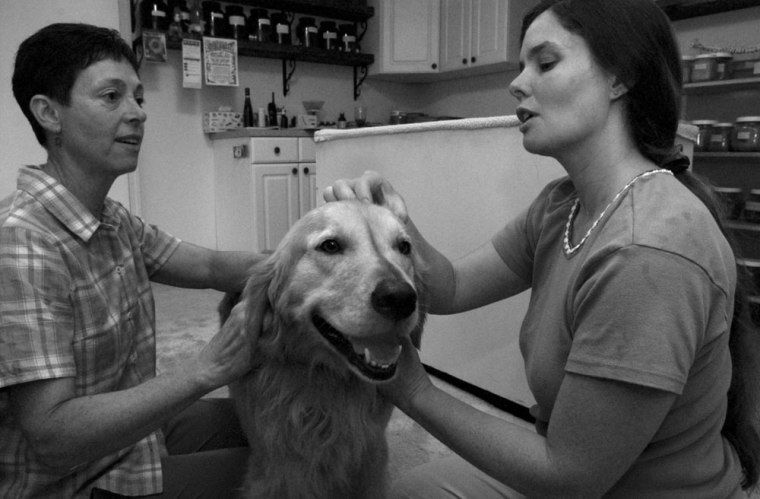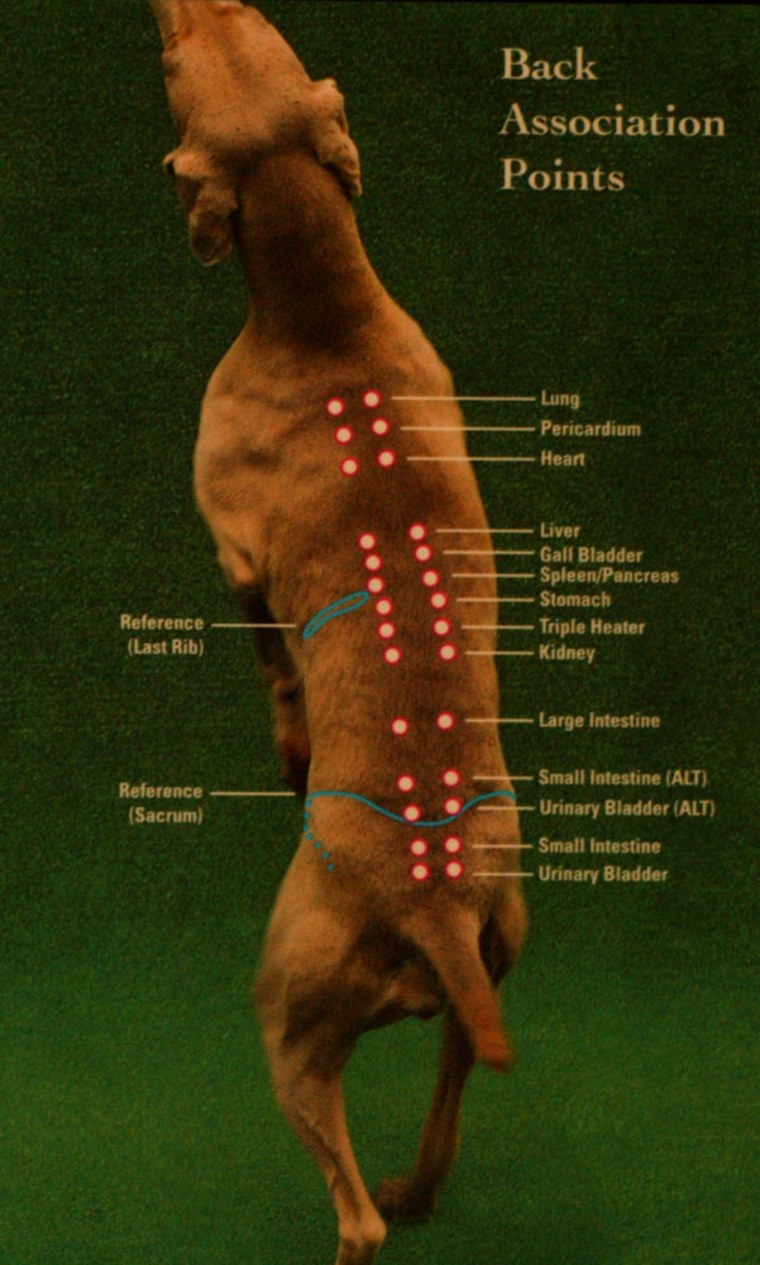Mella the golden retriever was an itchy dog — a very itchy dog. Each night she would stay awake frantically scratching at the burning sores and scaly skin covering her body. As her allergies grew worse, the soft skin on her belly turned black with scabs and the tissue between her toes grew red and inflamed. Eventually much of her fur had to be shaved off.
“She was a disaster,” says Pat Moberly, Mella’s owner. Originally bred to become a guide dog for people with disabilities, Mella had to drop out of the training program when the severity of her skin allergies became apparent.
Moberly tried everything she could think of — conventional medications, changing the dog’s diet, using different bedding and even avoiding grasses — but nothing stopped the endless itching. Nothing, that is, until she took Mella to see Dr. Donna Kelleher, a Seattle veterinarian trained in animal acupuncture and other forms of complementary medicine.
Puppy or pincushion?
Like Mella, many of Kelleher’s patients come to see her after conventional medical treatments have failed. Author of “The Last Chance Dog,” Kelleher specializes in treating animals with chronic diseases, some of which are close to being put down by the time they arrive for an appointment. She has done acupuncture on everything from a horse to a bird — even a pet snake that was slammed in a drawer and suffered spinal injuries.

As I drove to Kelleher’s office on a rainy August morning, I wondered about the logistics of performing acupuncture on animals. How does one stick a large dog with numerous needles and then make it sit still for 20 minutes? And how many people would it take to hold down a struggling golden retriever while a vet put pins in its paws and ears?
Fortunately the situation turned out to be a little more serene for everyone involved. Inside Kelleher’s office, filled with jars of Chinese herbs and charts showing acupuncture points on various animals, the only excitement was Mella bounding around the small room, happily wagging her tail.
As soon as Kelleher began the acupuncture treatment, the dog settled down on the floor and hardly seemed to notice the needles that were being inserted at points all over her body — inside her hind legs, on her back, shoulders, behind her ears and in her paws. Instead of becoming agitated or trying to pull out the needles, Mella conked out, her head in Moberly’s lap. For the next 20 minutes, she lay there panting lightly and occasionally yawning, her eyes glazed over in a doggy trance.
Was Mella a mutant pooch — a hound into sadomasochism? Or, this being her seventh acupuncture appointment, maybe she was just used to all this by now. But after watching two other less-experienced dogs undergo a similar treatment — neither of which seemed to care much about the needles either — Mella’s behavior didn’t seem so unusual.
And, the dog does seem to have gotten better. Months after the acupuncture began, her sores have nearly disappeared, she’s not scratching much, and the skin on her belly and toes has returned to normal, says Moberly.
“The improvement has been incredible. I really feel like I got my Mella-girl back.”
Roots in China
Used for thousands of years on humans in China, acupuncture involves inserting needles at various points on the body to create a healing reaction. Research suggests that most of these acupuncture points are located at the site of major nerve bundles and blood vessels. When the needles are inserted, it's believed that various nerves are activated, creating a cascading effect of increased circulation and the release of anti-inflammatory chemicals and natural painkillers.
"It's really about stimulating neurological points around the body," says Narda Robinson, a veterinarian and adjunct faculty member at Colorado State University's College of Veterinary Medicine and Biomedical Sciences. Using brain scans, Robinson is currently studying the linkage between acupuncture points and areas in the brains of animals.
The popularity of animal acupuncture in the United States began in the 1970s with the growing interest in alternative medicine. "As more people started looking into complementary medicine for their own health care, they started looking into it for their animals," says Dr. Ed Boldt, executive director of the International Veterinary Acupuncture Society, which offers a training course for veterinarians.
Despite the relatively recent growth of animal acupuncture in this country, the practice is nothing new — the Chinese have been doing it for centuries. The one hitch was that they only created charts of acupuncture points for certain critters, namely horses, cattle, pigs and other farm animals of economic significance, says Boldt. Dogs and cats were more likely to end up on the dinner table.

Without earlier charts to go by, modern veterinarians have learned to transpose known acupuncture points in humans onto pets. So, for instance, a point that is at the tip of the collarbone in a human is presumed to be at the same location in a cat or a gerbil. "Obviously there are problems with this system," says Boldt. "We have five fingers and five toes, but horses have a hoof. ... It's not as complicated with a dog or a cat because they still have similar anatomical features as us, but there are some limitations."
Even though relatively little is known about the actual physiological processes behind acupuncture, proponents of the practice swear by it. Most mainstream veterinarians, however, are still waiting for more solid scientific evidence that the procedure actually works and isn't harmful.
"Of the various alternative types of therapies, it's probably the most commonly used one," says Dr. Bonnie Beaver, president of the American Veterinary Medical Association. "But the problem with those therapies in general is that they do not have a lot of research behind them. ... All of us would love to see research in the area that's published and peer-reviewed to show us if it's beneficial and, if so, when."
Not a cure-all
Far from a cure-all, acupuncture is primarily used for the treatment of certain conditions in animals, such as arthritis, spinal injuries, allergies, skin problems, asthma and gastrointestinal disorders.
"One great rule of thumb is that it's good for use for chronic diseases — things that don't generally get better with Western medicine," says Kelleher. Within about three or four visits, a veterinarian should be able to see results if the treatment is going to work. Otherwise, it should be discontinued and another approach tried, she adds.
In order to determine if acupuncture is having a positive effect, the veterinarian relies on subjective reports from the owner, such as how the animal is eating, exercising and sleeping, as well as more objective tests, such as a visible improvement of symptoms.
"The beneficial effects of acupuncture are usually so pronounced that you don't have to guess whether it's working," says Robinson. "If the results are not clear enough, there might be something that could work better."
But what about the placebo effect? While it's generally accepted that suggestion can play a strong role in humans, is there such a thing in animals?
According to Boldt, it's probably pretty tricky to communicate to the average pet that sticking it with needles is going to cure its aches and pains. "But, you told the owner what's going to happen and in that way you could actually be doing a placebo effect on the owner," he adds.
An owner may desperately want something to happen and, as a result, could look for signs of improvement when there really aren't any. For this reason, it's important for the veterinarian to closely monitor the animal's symptoms and suggest a different treatment if acupuncture doesn't appear to be working, says Boldt.
Caveat emptor
Which brings me to the next point — namely that animal acupuncture is not something you want to have performed on your pet by any Tom, Dick or Harriet. And, of course, don't try it at home.
Inexperienced or improperly trained practitioners can easily wreak havoc on an animal's body. Penetration of a major organ or blood vessel could occur, or a severe illness requiring conventional veterinary medicine, such as cancer, could be ignored.
"We're seeing more and more cases of misdiagnosis or missed problems that could eventually become serious," says Robinson, who urges pet owners to seek out only licensed veterinarians who have completed at least 120 hours of formal training in animal acupuncture.
The veterinarian should be able to fully describe what will be done to the animal, including the potential benefits and risks. Pet owners should feel comfortable enough to ask questions and stay in the room at the time of the treatment.
"If not, they should find another practitioner," says Robinson.